Glimpses of Tibetan History
 A illustrated book including the 25 panels of an exhibition (in the book format, it comes to 56 pages) published by The Tibet Museum of Department of Information and International Relations, Central Tibetan Administration in Dharamsala...
Tittle: Glimpses of Tibetan History
A illustrated book including the 25 panels of an exhibition (in the book format, it comes to 56 pages) published by The Tibet Museum of Department of Information and International Relations, Central Tibetan Administration in Dharamsala...
Tittle: Glimpses of Tibetan HistoryISBN: 9789380091365
Place of Publication: Dharamsala, India
Publisher: Tibet Museum
Year of Publication: 2013
Physical Description: 56 p.
Book Format: Hard bound
1962 and the McMahon Line Saga
 India went through a tragic event which has remained a deep scar in the country’s psyche: a border war with China. During the author’s archival peregrinations on the Himalayan border, he goes into some relatively little known issues, such as the checkered history of Tawang; the British India policy towards Tibet and even the possibility for India to militarily defend the Roof of the World.
India went through a tragic event which has remained a deep scar in the country’s psyche: a border war with China. During the author’s archival peregrinations on the Himalayan border, he goes into some relatively little known issues, such as the checkered history of Tawang; the British India policy towards Tibet and even the possibility for India to militarily defend the Roof of the World.
ISBN: 9781935501404
Place of Publication: New Delhi, India
Publisher: Lancer Publishers
Year of Publication: October 2012
Physical Description: 560 p.
Book Format: Hard bound
Language: English
Threat from China
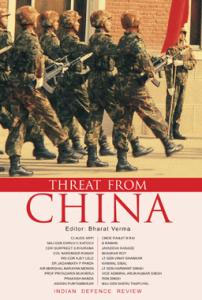 The multi-dimensional threat between 2011 and 2014 from China is real.The threat from China has crept to level ‘Orange’ for the past many years and the creeping invasion built over decades displays great features of stealth.
The multi-dimensional threat between 2011 and 2014 from China is real.The threat from China has crept to level ‘Orange’ for the past many years and the creeping invasion built over decades displays great features of stealth.
China primarily feels threatened by existence of the Union of India as it challenges their ambition of being the unilateral power leading Asia. Instead of integration of the citizenry and consolidation of different regions, our shortsighted politicians extend a helping hand to China and Pakistan by dividing Indians internally for vote-bank-politics.
Indians continue to live in isolated compartments of their making without inter-linkages with the big picture. This compartmentalized thinking is a cultural defect that ensures absence of connectivity with other multiple lateral tactical pictures. These small pictures if sensibly stitched together create ‘whole’ which helps in formulation of a grand strategy.
In this volume, Indian Defence Review with the help of its contributors provides, a fairly integrated picture of the multi-dimensional threat that China poses, and offers many fresh alternatives.
IN THIS VOLUME:
CLAUDE ARPI • MAJ GEN DHRUV C KATOCH • CDR GURPREET S KHURANA • COL NARENDER KUMAR • WG CDR AJEY LELE • DR JAGANNATH P PANDA • AIR MARSHAL NARAYAN MENON • PROF PRIYADARSI MUKHERJI • PRAKASH NANDA • ASHISH PUNTAMBEKAR • CMDE RANJIT B RAI • B RAMAN • JAYADEVA RANADE • BHASKAR ROY • LT GEN VINAY SHANKAR • KANWAL SIBAL • LT GEN HARWANT SINGH • VICE ADMIRAL ARUN KUMAR SINGH • RSN SINGH • MAJ GEN SHERU THAPLIYAL
ISBN: 978-1-935501-305v
Place of Publication: New Delhi
Publisher: Lancer Publishers
Year of Publication: January 2011
Physical Description: 548 p.
Book Format: Hardcover
Language: English
The Negotiations that never were
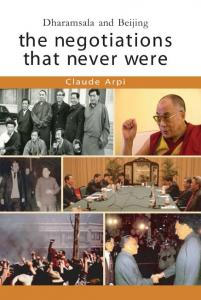 In October 1950, Communist China invaded Tibet. After nine years of difficult co-habitation with the occupiers, the Dalai Lama, the young temporal and spiritual leader of the Tibetans, had no choice but to flee his country to take refuge in India.
In October 1950, Communist China invaded Tibet. After nine years of difficult co-habitation with the occupiers, the Dalai Lama, the young temporal and spiritual leader of the Tibetans, had no choice but to flee his country to take refuge in India.
Subtitle: Dharamsala and Beijing
ISBN: 978-1-935501-19-0
Place of Publication: New Delhi
Publisher: Lancer Publishers
Year of Publication: October 2009
Physical Description: 295 p.
Book Format: Hardcover
Language: English
The Lost Frontier
 Plunging deep into the history of the Roof of the World, this book introduces us to one of the greatest tragedies of modern times, its main characters as well as the forces moving them, consciously or unconsciously.
Plunging deep into the history of the Roof of the World, this book introduces us to one of the greatest tragedies of modern times, its main characters as well as the forces moving them, consciously or unconsciously.The year 1950 was certainly one such crucial year in the destinies of India, Tibet and China. The three nations had the choice of going towards peace and collaboration, or tension and confrontation.
Decisions can be made with all good intentions — as in the case of Nehru who believed in an ‘eternal friendship’ with China — or with less good motives as for Mao. Decisions can be made out of weakness, greed, pragmatism, ignorance or fear, but once a choice is made, consequences unfold for years and decades thereafter.
The key to peace in Asia today lies on the Tibetan plateau. This study of the history of Tibet, a nation sandwiched between two giant neighbours, will help the student of geopolitics to grasp better the tumultuous relations between India and China, particularly the recent events in Tibet and the border dispute with China
ISBN: 978-0-9815378-4-9
Place of Publication: New Delhi
Publisher: Lancer Publishers
Year of Publication: 2008
Physical Description: 330 p.
Book Format: Hardcover Language: English
Uniting People: Jean Monnet – the Construction of Europe (Editor)
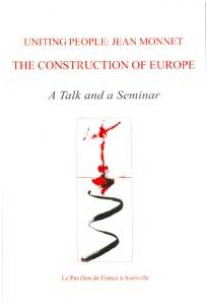 To mark the 50th anniversary of the Treaty of Rome which established the European Economic Community and to recall the contribution to European unity made by the exceptional personality of Jean Monnet, a seminar-cum-round table was held at the India International Centre in Delhi on February 2, 2007.
To mark the 50th anniversary of the Treaty of Rome which established the European Economic Community and to recall the contribution to European unity made by the exceptional personality of Jean Monnet, a seminar-cum-round table was held at the India International Centre in Delhi on February 2, 2007.
Chancellor Helmut Schmidt: “Monnet is the rare example, I should say the unique example, of a politician who could realize his objectives without this essential element of politics that is power.”
US President John F. Kennedy to Jean Monnet: “You are transforming Europe by the power of a constructive idea.”
Title: Uniting People: Jean Monnet
Subtitle:The Construction of Europe
ISBN: 8187373-35-0
Place of Publication: Auroville
Publisher: Le Pavillon de France à Auroville
Year of Publication: 2007
Physical Description: 248p., Photos; 21cm.
Book Format: Softcover
Language: English
India and Her Neighbourhood
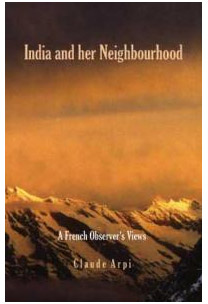 A French Observer’s Views
A French Observer’s ViewsFor the past 30 years, Claude Arpi has been a keen observer of the political developments in India and her neighbourhood. In the early 90’s, he started has writing on current affairs in the region, sharing with his readers his research on the history of the subcontinent.
Subtitle: A French Observer’s Views
ISBN: 8124110972
Place of Publication: New Delhi
Publisher: Har Anand Publications Pvt. Ltd.
Year of Publication: 2005
Physical Description: 364p., Index; 23cm.
Book Format: Hardcover
Language: English
Born in Sin: The Panchsheel Agreement
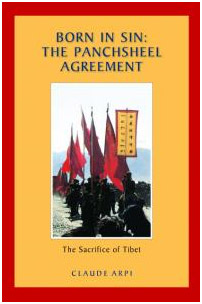 The Sacrifice of Tibet
The Sacrifice of Tibet
A hundred yeas ago a young British Colonel, Francis Younghusband entered the holy city of Lhasa and forced upon the Tibetans their first Agreement with the mighty British empire. In signing this treaty with the Crown, Tibet was acknowledged as a separate nation by the British.
However, an event changed the destiny of the land of Snows. In October 1950, Mao Zedong’s troops invaded Tibet. With this background, the present research looks at the genesis of the Panchsheel Agreement between India and China which converted the Land of snow into merely Tibet’s Region of China. A natural and cultural buffer zone between India and China disappeared.
The preamble of the Agreement contained the Five Principles which formed the main pillar of India’s foreign policy for the next fifty years. It was the beginning of the Hindi-Chini Bhai-Bhai policy and India’s non-aligned position. This policy still haunts an India unable to sort out her border tangle with China. The study concludes with some tentative but constructive proposals to come out of the current impasse.
In India, one often hears of Panchsheel, but few know that it only was an Agreement on Trade and Intercourse between the Tibet region of China and India signed between China and India on April 29, 1954. Since the preamble of this Agreement contained the famous Five Principles, it was dubbed the Panchsheel Agreement.
Though it lapsed in 1962 and was never renewed, it has kept its aura as the ideal solution for foreign relations. But its first consequence was that Tibet, a 2000 years-old nation, was erased from the map of Asia. During a debate in Parliament in 1958, the Socialist leader Acharya Kripalani stated:
This great doctrine was born in sin, because it was enunciated to put the seal of our approval upon the destruction of an ancient national which was associated with us spiritually and culturally. It was a nation which wanted to lives its own life and it sought to have been allowed to live its own life. The 1962 Sino-Indian conflict was another consequence of the Panchsheel Policy.
Subtitle: The Sacrifice of Tibet
ISBN: 817099974X
Place of Publication: New Delhi
Publisher: Mittal Publicationsvv Year of Publication: 2004
Physical Description: xxii+241p., Photos; Maps; 22cm.
Book Format: Hardcover
The Fate of Tibet (out of print)
 Foreword
ForewordWhen Tibet was free, we took our freedom for granted. We had little sense that it was something we had to prove or even defend, because we were unaware that it was under threat. We simply regarded ourselves as ’the red faced, black haired people of the Land of Snow.’
With the advent of Buddhism our military prowess declined, but this change in attitude ultimately spawned rich new relations with India, China and Mongolia that were cultural and religious in nature. Sadly, we failed to develop sufficient political awareness for the times. Great changes were taking place all around us.
To the south India was gaining her independence and to the east China was undergoing civil war and revolution. Meanwhile, Tibet remained much the same. To our cost, we underestimated how these changes would affect us. However, I believe that since then our powerful neighbours have profoundly underestimated how the upheaval that has taken place in Tibet affects them.
As a neutral state at the heart of Asia, Tibet has traditionally acted as a buffer between India and China, both now nuclear powers. A buffer that presently no longer exists.
As the ’roof of the world’ and the source of several great rivers, the Tibetan plateau has also great influence on regional climate, thus environmental changes there have far-reaching effects in East and South Asia.
Finally, as a rich repository of living Buddhist culture and tradition, Tibet has a great deal to offer in the quest for inner peace and the encouragement of nonviolence and peace in the world at large. In this book, Claude Arpi, an old friend of Tibet and Tibetans, deals with many of these themes. Taking a long perspective from ancient times to the present he shows how Tibet’s interests have always been interdependent with those of her neighbours and vice versa. Consequently, resolution of the current impasse on Tibet will only be settled by dialogue that acknowledges this reality.
I have proposed the establishment of Tibet as a Zone of Peace that would address the needs of our neighbours as well as our own. However, such a solution can only be achieved if all the interested parties are prepared to enter into discussions. Until now the Chinese side has resolutely avoided doing so. Claude Arpi has spent many years of his life in India and has acquired a thorough understanding of the Tibetan issue.
While he expresses an admiration for the good spirited resilience of Tibetans that has inspired him in his work, I would like to state my admiration for his own down to earth and practical attitude. He is a man who assesses what needs or can be done and settles down to doing it. This same approach is reflected in this book.
I believe readers will find that he casts a much clear light on the issue of Tibet, which I hope will in turn inspire them to give support to our cause. July 15, 1999
Title: The Fate of Tibet
Subtitle: When Small Insects eat big insect
ISBN: 812410638X
Place of Publication: New Delhi
Publisher: Har Anand Publications Pvt. Ltd.
Year of Publication: 1999
Physical Description: 432p., Plates.
Book Format:Paperback
Language: English
And Land and Dark shall be the night
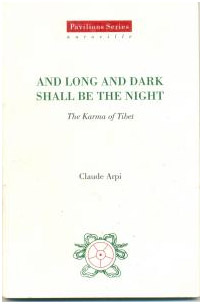 The Karma of Tibet
The Karma of TibetThis study is a continuation of the “The Fate of Tibet”. That book had historically explained what befell the Tibetan nation, but had admitted that in the Tibetan tradition, historical facts are only the most external manifestations of deeper forces and struggles, in which many other factors, such past actions of individuals or nations, have to be taken into consideration.
This research is limited to the twentieth century, as the objective was just to give a gist of what went wrong in the recent past. There was no need to go further down in history to prove this point.
Sub-title: The Karma of Tibet
ISBN: 81-87373-23-7
Publisher: Pavilion of Tibetan Culture, Auroville, India
Year of Publication: 2002
Physical Description: 96 p., 21 x 14 cm
Book Format: Soft cover
Language: English
Pondicherry: The last months before India’s Independence
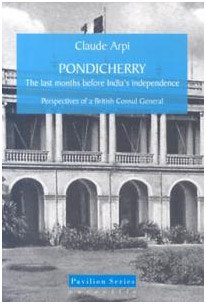 Perspectives of a British Consul General
Perspectives of a British Consul GeneralOn June 3, 1947, Lord Mountbatten, the Viceroy called a Press Conference to announce that his government had decided to leave the Indian subcontinent by August 15 of the same year. Two hundred years of British colonization of the Jewel in the Crown had come to an end.
The interest in Fletcher’s dispatches is that they regularly and minutely informed the Department of External Affairs of British India in Delhi of the latest developments in Pondicherry.
The evolution of the political situation in French India is followed from a British officer’s perspective. This study is however balanced by other documents, mainly from the French Archives.
Sub-title: Perspectives of a British Consul General
ISBN: 81-87373-30-X
Publisher: Auroville Press Publishers, Auroville, India
Year of Publication: 2005
Physical Description: 68 p., photos.
Book Format: Soft cover
Language: English
The Dalai Lama in Auroville
 The visit
December 23-24, 1993
The visit
December 23-24, 1993His Holiness the Dalai-Lama, spiritual and temporal leader of the Tibetan people visited the International Township of Auroville on 23rd and 24th December 1993.This was the Dalai Lama’s second visit to Auroville
For five days before the visit of His Holiness the Dalai Lama, Auroville recorded the heaviest torrential rains it had witnessed for decades at this time of the year. Usually the SW monsoon is finished by early December and we thought that we would enough time to repair the roads.
During the last weeks before the 23rd December, Auroville saw more activities that it had seen for years as we tried to get everything ready for the visit in particular the Sri Aurobindo Auditorium in Bharat Nivas and the site of thePavilion.
The first small miracle of the visit was that in the afternoon of the 23rd when His Holiness reached Auroville at around 3 p.m., the rain stopped. He was first taken to Forecomers, which was the first settlement in Auroville; it used to be a bare plateau of red laterite and it is now a forest with hundreds of different species of trees.
Knowing the Dalai Lama’s interest in environment, we had thought that he should first meet with the Aurovilians having worked on the regeneration of the life of the soil of Auroville.He then proceeded to Pitanga Hall, the multipurpose cultural centre for Auroville near Samasti.
To coincide with the Dalai-Lama’s visit an exhibit of the photographs of the renown Indian photographer Raghu Rai, taken from his book Tibet In Exile, was held for one month in Pitanga Hall where His Holiness took the opportunity to look at the Yoga and Dance class rooms.
The Dalai Lama next visited the Matrimandir, the ‘Soul of Auroville’. He could sit with his close entourage and meditate in the Inner Chamber for a few minutes.
Before retiring to his room, he was taken to the orchid section of the Matrimandir Nursery where his deep knowledge of flowers and in particular, orchids impressed everyone present.
On the 24th morning, after having given an interview to the Auroville’ monthly newspaper Auroville Today, His Holiness laid the Foundation Stone for the Pavilion of Tibetan Culture, under a cloudless sky, in Auroville’s International Zone.
It was a very intense moment, while he was laying the Foundation Stone (which had specially been brought from Tibet for the occasion), Tibetan monks from Ganden Monastery recited Tibetan prayers and later a group of children of Auroville sign Sanskrit Hymns to the Divine Mother.
Before leaving the site, His Holiness planted a Christmas tree to commemorate the occasion of his visit.Before addressing Auroville in the Sri Aurobindo Auditorium, he paid a short visit to Auroville’s Future, the Architecture and Planning Office of Auroville.He could see the plans/maps of Auroville, in particular of the International zone and of the Tibetan Pavilion.
He then addressed a large gathering of Aurovilians and friends who had come from Pondicherry on one of His Holiness’ favorite theme: the importance of Love, Compassion for a society.Later we visited the Information & Reception Centre which is a large complex made of compressed earth blocks, where our visitor’s information centre, a boutique, a cafetaria and multipurpose exhibition rooms are located.His Holiness shown a lot of interest for the use of non-conventional sources of energies for the complex and in particular for the windmill.
At the time of His Holiness’ visit, an exhibition was held in collaboration with the Italian Embassy in New Delhi. The team looking after the Italian Pavilion in Auroville had organized an Italian week in which artists from Italy are participating. This is part of the activities of the International Zone.
The Center for Scientific Research (CSR) is the place where many Tibetans have been trained in appropriate building technology (ferro-cement, mud bricks, chulas, etc...). It is also in collaboration with the CSR that the "Awareness Workshop for a Sustainable Future of Tibet" was held last July. Many of these training programs are made in collaboration with Aptt Trust of UK.
At the end of the morning His Holiness went to Transition School where he met some 35 teachers and some senior students of Auroville. An extremely interesting debate followed on the different systems of education and in particular on non-formal education experiments attempted in Auroville schools.
Before leaving for Madras, His Holiness had a lunch in Dana Community with the team who had organized his visit to Auroville.It is difficult to sum up with words such an event in the life of Auroville but it will be surely be remembered by all as the great moments in Auroville history.This is due without doubt to the sincerity, the kindness, the compassion, the simplicity and humour to this man who like to say that he is just a simple monk.January 1994
Place of Publication: Auroville, India
Publisher: Pavilion of Tibetan Culture
Edition: 1st ed.
Year of Publication: 1994v
Physical Description: 46 p., 14 x 21 cm photos.
Book Format: Soft cover
Language: English
Revue de L’Inde (Special Kashmir, Spring 2007) – Some Translations
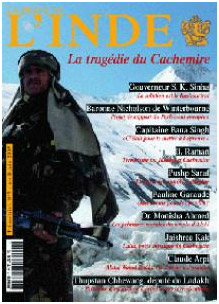 Guest Editor:Claude Arpi
Guest Editor:Claude Arpi
We are offering here the English version of some of the articles published in the Special Issue of La Revue de l’Inde (No 7) dedicated to Jammu and Kashmir.




